
Concept explainers
(a)
Interpretation:
It is to be determined whether each of the following syntheses requires a reaction that alters the carbon skeleton.
Concept introduction:
Chemical syntheses are carries out by transforming one
Answer to Problem 13.29P
This chemical synthesis does require a reaction that alters the carbon skeleton because a carbon-carbon
Explanation of Solution
The given chemical synthesis is
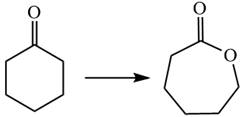
The starting compound is a six carbons ring whereas the product is a seven membered ring with one oxygen atom. Thus, the arrangement of carbon atoms in the product has changed by breaking the carbon-carbon
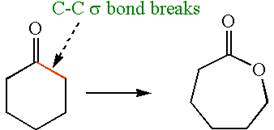
Therefore, this transformation requires a reaction that alters the carbon skeleton.
It is determined that the synthesis requires a reaction that alters the carbon skeleton based on the change in the arrangement of carbon atoms.
(b)
Interpretation:
It is to be determined whether each of the following syntheses requires a reaction that alters the carbon skeleton.
Concept introduction:
Chemical syntheses are carries out by transforming one functional group to another. If the bonding arrangement of carbon atoms remains the same in the product formed, that means the synthesis does not require a change in the carbon skeleton. If it is changed, that means the synthesis requires a change in the carbon skeleton. The forming or breaking of carbon-carbon
Answer to Problem 13.29P
This chemical synthesis does not require a reaction that alters the carbon skeleton as there is no need to break or form a carbon-carbon
Explanation of Solution
The given chemical synthesis is

The starting compound is an alcohol, and the product is ether. The transformation occurs by replacement of the hydrogen attached to oxygen by the isopropyl group, which requires breaking of
It is determined that the synthesis does not require a reaction that alters the carbon skeleton based on the retention of the arrangement of carbon atoms.
(c)
Interpretation:
It is to be determined whether each of the following syntheses requires a reaction that alters the carbon skeleton.
Concept introduction:
Chemical syntheses are carries out by transforming one functional group to another. If the bonding arrangement of carbon atoms remains the same in the product formed, that means the synthesis does not require a change in the carbon skeleton. If it is changed, that means the synthesis requires a change in the carbon skeleton. The forming or breaking of carbon-carbon
Answer to Problem 13.29P
This chemical synthesis does require a reaction that alters the carbon skeleton because a carbon-carbon
Explanation of Solution
The given chemical synthesis is

In this chemical synthesis, the

It means there is a formation of carbon-carbon
It is determined that the synthesis requires a reaction that alters the carbon skeleton based on the change in the arrangement of carbon atoms.
(d)
Interpretation:
It is to be determined whether each of the following syntheses requires a reaction that alters the carbon skeleton.
Concept introduction:
Chemical syntheses are carries out by transforming one functional group to another. If the bonding arrangement of carbon atoms remains the same in the product formed, that means the synthesis does not require a change in the carbon skeleton. If it is changed, that means the synthesis requires a change in the carbon skeleton. The forming or breaking of carbon-carbon
Answer to Problem 13.29P
This chemical synthesis does not require a reaction that alters the carbon skeleton because carbon-carbon
Explanation of Solution
The given chemical synthesis is

The starting compound is an
It is determined that the synthesis does not require a reaction that alters the carbon skeleton based on the retention of arrangement of carbon atoms.
(e)
Interpretation:
It is to be determined whether each of the following syntheses requires a reaction that alters the carbon skeleton.
Concept introduction:
Chemical syntheses are carries out by transforming one functional group to another. If the bonding arrangement of carbon atoms remains the same in the product formed, that means the synthesis does not require a change in the carbon skeleton. If it is changed, that means the synthesis requires a change in the carbon skeleton. The forming or breaking of carbon-carbon
Answer to Problem 13.29P
This chemical synthesis does require a reaction that alters the carbon skeleton because a carbon-carbon
Explanation of Solution
The given chemical synthesis is
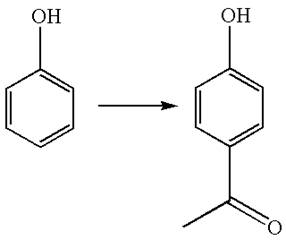
In this chemical synthesis, the hydrogen atom of benzene is replaced by the acetyl group,
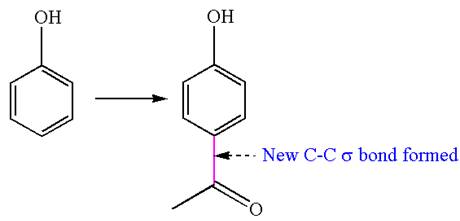
Therefore, this synthesis requires a reaction that alters the carbon skeleton.
It is determined that the synthesis requires a reaction that alters the carbon skeleton based on the change in the arrangement of carbon atoms.
(f)
Interpretation:
It is to be determined whether each of the following syntheses requires a reaction that alters the carbon skeleton.
Concept introduction:
Chemical syntheses are carries out by transforming one functional group to another. If the bonding arrangement of carbon atoms remains the same in the product formed, that means the synthesis does not require a change in the carbon skeleton. If it is changed, that means the synthesis requires a change in the carbon skeleton. The forming or breaking of carbon-carbon
Answer to Problem 13.29P
This chemical synthesis does require a reaction that alters the carbon skeleton because a carbon-carbon
Explanation of Solution
The given chemical synthesis is

The starting compound has a five carbons ring with double bond, and the product has a five carbons ring fused with a three-membered ring. This could occur by breaking of carbon-carbon

Therefore, this synthesis requires a reaction that alters the carbon skeleton.
It is determined that the synthesis requires a reaction that alters the carbon skeleton based on the change in arrangement of carbon atoms.
(g)
Interpretation:
This chemical synthesis does require a reaction that alters the carbon skeleton because a carbon-carbon
Concept introduction:
Chemical syntheses are carries out by transforming one functional group to another. If the bonding arrangement of carbon atoms remains the same in the product formed, that means the synthesis does not require a change in the carbon skeleton. If it is changed, that means the synthesis requires a change in the carbon skeleton. The forming or breaking of carbon-carbon
Answer to Problem 13.29P
No, this chemical synthesis does not require a reaction that alters the carbon skeleton because carbon-carbon
Explanation of Solution
The given chemical synthesis is

The starting compound is an alkene, and the product is
It is determined that the synthesis does not require a reaction that alters the carbon skeleton based on the retention of arrangement of carbon atoms.
(h)
Interpretation:
It is to be determined whether each of the following syntheses requires a reaction that alters the carbon skeleton.
Concept introduction:
Chemical syntheses are carries out by transforming one functional group to another. If the bonding arrangement of carbon atoms remains the same in the product formed, that means the synthesis does not require a change in the carbon skeleton. If it is changed, that means the synthesis requires a change in the carbon skeleton. The forming or breaking of carbon-carbon
Answer to Problem 13.29P
This chemical synthesis does require a reaction that alters the carbon skeleton because a carbon-carbon
Explanation of Solution
The given chemical synthesis is
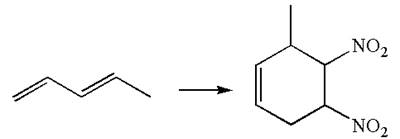
The starting compound has a five carbons chain with two conjugated double bonds, and the product has a six carbons ring fused. This could occur by breaking of carbon-carbon
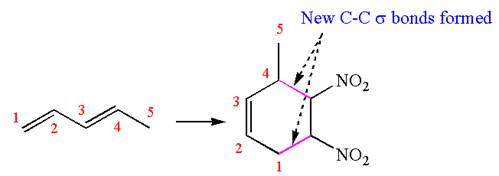
Therefore, this synthesis requires a reaction that alters the carbon skeleton.
It is determined whether the synthesis requires a reaction that alters the carbon skeleton based on the change in the arrangement of carbon atoms.
Want to see more full solutions like this?
Chapter 13 Solutions
EBK ORGANIC CHEMISTRY: PRINCIPLES AND M
- Predict the major products of this organic reaction: 1. LIAIHA 2. H₂O ? Note: be sure you use dash and wedge bonds when necessary, for example to distinguish between major products with different stereochemistry. Click and drag to start drawing a structure. X : ☐arrow_forwardFor each reaction below, decide if the first stable organic product that forms in solution will create a new C - C bond, and check the appropriate box. Next, for each reaction to which you answered "Yes" to in the table, draw this product in the drawing area below. Note for advanced students: for this problem, don't worry if you think this product will continue to react under the current conditions - just focus on the first stable product you expect to form in solution. NH2 tu ? ? OH Will the first product that forms in this reaction create a new CC bond? Yes No Will the first product that forms in this reaction create a new CC bond? Yes No C $ ©arrow_forwardAs the lead product manager at OrganometALEKS Industries, you are trying to decide if the following reaction will make a molecule with a new C-C bond as its major product: 1. MgCl ? 2. H₂O* If this reaction will work, draw the major organic product or products you would expect in the drawing area below. If there's more than one major product, you can draw them in any arrangement you like. Be sure you use wedge and dash bonds if necessary, for example to distinguish between major products with different stereochemistry. If the major products of this reaction won't have a new CC bond, just check the box under the drawing area and leave it blank. Click and drag to start drawing a structure. This reaction will not make a product with a new CC bond. G marrow_forward
- Including activity coefficients, find [Hg22+] in saturated Hg2Br2 in 0.00100 M NH4 Ksp Hg2Br2 = 5.6×10-23.arrow_forwardgive example for the following(by equation) a. Converting a water insoluble compound to a soluble one. b. Diazotization reaction form diazonium salt c. coupling reaction of a diazonium salt d. indacator properties of MO e. Diazotization ( diazonium salt of bromobenzene)arrow_forward2-Propanone and ethyllithium are mixed and subsequently acid hydrolyzed. Draw and name the structures of the products.arrow_forward
- (Methanesulfinyl)methane is reacted with NaH, and then with acetophenone. Draw and name the structures of the products.arrow_forward3-Oxo-butanenitrile and (E)-2-butenal are mixed with sodium ethoxide in ethanol. Draw and name the structures of the products.arrow_forwardWhat is the reason of the following(use equations if possible) a.) In MO preperation through diazotization: Addition of sodium nitrite in acidfied solution in order to form diazonium salt b.) in MO experiment: addition of sodium hydroxide solution in the last step to isolate the product MO. What is the color of MO at low pH c.) In MO experiment: addition of sodium hydroxide solution in the last step to isolate the product MO. What is the color of MO at pH 4.5 d.) Avoiding not cooling down the reaction mixture when preparing the diazonium salt e.) Cbvcarrow_forward
- A 0.552-g sample of an unknown acid was dissolved in water to a total volume of 20.0 mL. This sample was titrated with 0.1103 M KOH. The equivalence point occurred at 29.42 mL base added. The pH of the solution at 10.0 mL base added was 3.72. Determine the molar mass of the acid. Determine the Ka of the acid.arrow_forwardAs the lead product manager at OrganometALEKS Industries, you are trying to decide if the following reaction will its major product: 2,0° with a new C-C bond as If this reaction will work, draw the major organic product or products you would expect in the drawing aree below. If there's more than one major product, you can draw them in any arrangement you like. Be sure you use wedge and desh bonds if necessary, for example to distinguish between major products with different stereochemistry. If the major products of this reaction won't have a new C-C bond, just check the box under the drawing area and leave it blank.arrow_forwardwrite the mechanism of the nucleophilic acyl substitution reaction, please give an examplearrow_forward
 Organic Chemistry: A Guided InquiryChemistryISBN:9780618974122Author:Andrei StraumanisPublisher:Cengage Learning
Organic Chemistry: A Guided InquiryChemistryISBN:9780618974122Author:Andrei StraumanisPublisher:Cengage Learning Chemistry for Today: General, Organic, and Bioche...ChemistryISBN:9781305960060Author:Spencer L. Seager, Michael R. Slabaugh, Maren S. HansenPublisher:Cengage Learning
Chemistry for Today: General, Organic, and Bioche...ChemistryISBN:9781305960060Author:Spencer L. Seager, Michael R. Slabaugh, Maren S. HansenPublisher:Cengage Learning World of Chemistry, 3rd editionChemistryISBN:9781133109655Author:Steven S. Zumdahl, Susan L. Zumdahl, Donald J. DeCostePublisher:Brooks / Cole / Cengage Learning
World of Chemistry, 3rd editionChemistryISBN:9781133109655Author:Steven S. Zumdahl, Susan L. Zumdahl, Donald J. DeCostePublisher:Brooks / Cole / Cengage Learning


